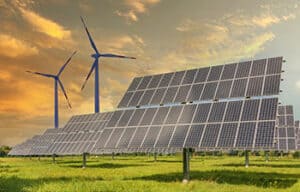
I’d like to give everyone a break from the dismal state of the markets and focus on a ray of hope sitting on the horizon: renewable energy commodities.
This covers a variety of commodities such as graphite, lithium, and nickel — essential components of modern battery technologies that will be key to our economy as we continue to transition away from fossil fuel derived energy sources.
Many of you will already have some exposure to this sector through Tesla Inc. (NASDAQ: TSLA) or Toyota Motor Corp (NASDAQ: TM), however, the energy metals market goes beyond electric cars, and there are other ways to gain more direct exposure.
Let’s take a dive into what the energy metals market outlook is and look at some ways you can gain exposure to the supply side of the equation.

We’ve touched on the potential of energy metals before. One of our contributors, MF Williams, noted the lithium trend back in 2021 (read more here), and it’s only been picking up steam since then.
The first trend is most visible — the rise of electric vehicles (EVs). By 2030 EVs are expected to account for 50% of all vehicle sales in the US, between 60–83% in the EU, and 40% in China.[1] This will result in a significant increase in the demand for the commodities essential to lithium-ion battery production, such as graphite and lithium.
The second ingredient in our demand cocktail is renewable energy. Despite a lack of government financing, renewable energy has proven to be incredibly efficient. All renewables are already more affordable than coal, and by certain calculations, renewable energy is currently the world’s cheapest energy source.[2]
This is good news, as many Western nations had already committed to decarbonizing in the Paris Climate Agreement.[3] These efforts to decarbonize saw another significant catalyst in the wake of the tragic Russian invasion of Ukraine in early 2022.
Europe has typically attempted to reduce its carbon impact by focusing on a combination of EVs and a reliance on relatively low-pollution natural gas. Unfortunately, around 41% of the European Union’s natural gas imports came from Russia.[4]
The shock of the Russian invasion, and the extreme violence that followed, has led to increasing calls for the bloc to end its reliance on Russian energy. This has resulted in plans for the EU to wean itself off Russian energy by 2030.[5]

Why is this important for this conversation? Well, the EU’s options for energy generation are limited. Coal is a non-starter if Europe wishes to maintain its position as a leader in the fight against climate change. Nuclear power is an option favored by France, however, Germany is still hesitant to support this option for ethical and practical reasons.[6]
This leaves Europe with one real option: renewables. Europe does produce a lot of energy via renewables, around 22% on average, with some outliers like Sweden producing up to 60% of their energy from renewables.[7] However, renewables have one big problem: They struggle to meet the base-load requirement for energy.
The best way to get around this is battery technology. Batteries can store excess energy and then release it back to the grid when the sun isn’t shining and the wind isn’t blowing. However, that brings us to the big problem here - there is a supply-side bottleneck, for now at least, and it’s going to be exacerbated by electric cars.

The EV industry alone is set to outstrip demand for key minerals like lithium, with some industry voices worried that we could run out of easily accessible material within the next decade.[8] For context, let’s take a look at graphite which makes up around 50% of the average lithium-ion battery.[9]
The average EV can contain up to 70kg of graphite.[10] So for every 1 million vehicles, you should need around 75,000 tonnes of graphite. By 2030, this means we are looking at a global demand of around 8 million tonnes annually for EVs alone. When you consider that the mining industry could supply just 1.1 million tonnes in 2020, this becomes a little overwhelming.
This has spooked governments around the world who are racing to secure their own national supply of key rare minerals and renewable energy commodities. For example, the Canadian government has already committed around CA$2 billion to secure a supply chain for its EV battery economy.[11] Ottawa (Canada) has gone even further, with pledges of CA$3.8 billion over the next 3 years.
The US has followed suit and has listed graphite, lithium, cobalt and a number of other energy commodities as essential to its natural security. This is particularly problematic in the case of graphite, where the US still imports 100% of its supply from abroad.[12]
This picture isn’t entirely perfect. It should be noted that supply of certain renewable energy commodities, notably lithium, is expected to outstrip demand in the medium term, and Goldman Sachs analysts are actually predicting a fairly aggressive correction in the price of lithium particularly for the next two years.
This brings us to the bit you’ve been waiting for: Which renewable energy commodities are likely to perform well and which should you be avoiding?
Since we can predict that the demand for certain materials, particularly nickel, graphite, and lithium, are likely to increase, then investing in companies that are looking to extract those materials is a good bet. This comes with significant risks of failure if you’re investing at an early stage and reduced rewards for more mature projects.
There are some broad similarities between the different battery metals/mineral mining operations, but the outlook for each individual sector differs — so let’s take a quick dive into three of the big ones: graphite, lithium, and nickel.

There were a number of companies that rushed into graphite when it became clear that demand should rise, but much of that demand has not yet materialized. This has led to a situation where a good deal of graphite mining operations have yet to secure offtake agreements, leaving them stalled.
By far the most well known graphite mining stock is Syrah Resources (OTC US: SYAAF / ASX: SYR). Despite securing an offtake deal with Tesla, Syrah Resources is not yet profitable.[13] The company is actually experiencing losses at the moment but it is expected to hit breakeven around 2023, and the company’s revenue forecasts were recently significantly upgraded.
With price targets of around AU$1.58, it is still trading a little under forecast. However, investors should also keep in mind that around 25% of Syrah’s equity is in debt. If the company misses its profit targets, this could cause significant problems down the line.

Aside from Syrah, there are a number of smaller graphite projects at the early stage that might make sense for risk tolerant investors. Take NextSource Materials (OTCQB: NSRCF / TSX: NEXT).

The company isn’t yet revenue generating, and it is firmly in the small-cap stage, however, it is one of a handful of companies that has already secured a supply agreement for around 100% of its phase one capacity. It has an agreement with a major Japanese EV product from 2018, and one with the German-based EV battery producer ThyssenKrupp AG.[14]
On the extreme end of the scale, we have microcap stocks that are far less along than NextSource or Syrah, adding yet more additional risk. These are stocks that risk-tolerant (or thrill-seeking) investors might want to look at.
For my part, I have made a small bet on Global Li-Ion Graphite Corp. (CSE: LION), another Canadian-based company with a presence in Madagascar. I believe that the company’s properties, combined with a solid management team, have the potential to provide easily accessible high-quality graphite. However, it is too early to give them an outright buy recommendation, but you will be the first to know how my bet turns out! This is a junior market investment punt on my part.


We’ve covered graphite — what about lithium? Until early June, lithium prices were skyrocketing. However, Goldman Sachs poured water on the fire with a report that argued that we will see drops of up to 73% in the price of lithium by next year.[15]
This meant that many major lithium mining stocks, notably Lithium Americas (NYSE: LAC), have since suffered a price correction. This effect is compounded by the large number of Chinese-based lithium mining projects coming to fruition, which will ensure strong supply-side fundamentals.
Now, this isn’t to say that I’m recommending against buying lithium mining stocks. The oversupply of lithium will enable carmakers and battery makers to more effectively operate. This will hopefully lead to a price resurgence in 2025 and beyond.
For my money, the best lithium strategy will be to stagger a number of smaller investments into companies such as Lithium Americas (NYSE: LAC). This will allow investors to benefit from the incoming price shock, while maintaining outsized exposure to stocks that will see a resurgence as the demand side of the lithium market becomes even more robust.


The outlook for nickel is a little more mixed than graphite or lithium. Nickel is a key component for the most common form of battery chemistry for cathodes.
While there is a trend towards nickel-free battery chemistries, there are still some strong fundamentals for nickel. The most important of which being that nickel-based NCM batteries chemistries are easier to recycle, which will become a key decision maker for manufacturers as governments seek to reduce electronic waste and work towards building a cleaner environment.
Another positive for nickel is geography. It will be difficult to scale the supply of nickel anytime soon, which means that it has a much softer tail-off than other energy metals for the next year or so. This does, however, mean that there might not be the same discount on nickel companies that we’ll see on lithium investments in the next 12 months, so possibly fewer opportunities to buy the dip.
For most FNN readers, Vale SA (NYSE: VALE) is likely our most watched nickel stock... While it is down from highs in June of last year, the stock has been performing well of late, and as the largest producer of nickel is probably a good way to get exposure to this important metal commodity.

So with all that said, are in-demand commodities the best way to gain exposure to the energy (electric) transition? I would say they are a key component of any green or renewable stock portfolio. A healthy combination of lithium, graphite, and nickel stocks will give you broad exposure to three of the most important commodities for battery production.
Once you have supply exposure, then I believe it's time to start looking at demand. As the report from Goldman Sachs highlights, short-term oversupply will reduce prices and give battery technology companies more breathing space to innovate and grow.[16]
This means that in the near future there will be a number of battery stocks, perhaps even fully integrated companies, that could provide even greater upside versus the commodity mining stocks most investors are currently following. I believe we need to look to the future.
I would recommend that you do your own research into the renewable energy commodity mining stocks mentioned, build a personalized investment portfolio plan, and decide how you can best invest and leverage the electric vehicle (EV) commodity opportunities on the horizon.

Saul Bowden, Contributor
for Investors News Service
P.S. To discover more opportunities in the hottest sectors in North America, sign up now to the Financial News Now newsletter to get the latest updates and investment ideas directly in your inbox!
DISCLOSURE: Saul Bowden holds LION, LAC, and other commodity stocks.
DISCLAIMER: Investing in any securities or cryptocurrencies is highly speculative. Please be sure to always do your own due diligence before making any investment decisions. Read our full disclaimer here.
[1] https://insideevs.com/news/548934/ev-sales-projected-near-6million/
[2] https://www.weforum.org/agenda/2021/07/renewables-cheapest-energy-source/
[3] https://www.nrdc.org/stories/paris-climate-agreement-everything-you-need-know
[4] https://www.bbc.com/news/58888451
[5] https://www.bbc.com/news/science-environment-61497315
[6] https://www.politico.eu/article/politics-behind-germany-refusal-reconsider-nuclear-phaseout/
[7] https://ec.europa.eu/eurostat/statistics-explained/index.php?title=Renewable_energy_statistics
[8]https://www.yicaiglobal.com/news/lithium-battery-raw-materials-to-be-exhausted-in-five-to-10-years-inventor-says
[9] https://www.ecograf.com.au/graphite/
[10] https://industryeurope.com/sectors/metals-mining/vianode-to-open-first-phase-plant-in-norway/
[11]https://www.reuters.com/business/exclusive-canada-spend-c2-bln-mineral-strategy-ev-battery-supply-chain-2022-04-04/
[12] https://www.visualcapitalist.com/the-50-minerals-critical-to-u-s-security/
[13] https://www.afr.com/companies/mining/syrah-signs-offtake-agreement-with-tesla-20211223-p59jr0
[14]https://investingnews.com/daily/resource-investing/battery-metals-investing/graphite-investing/nextsource-materials-signs-offtake-agreement-with-primary-graphite-supplier-to-major-japanese-electric-vehicle-anode-producer/
[15]https://www.goldmansachs.com/insights/pages/gs-research/battery-metals-watch-the-end-of-the-beginning/report.pdf
[16]https://www.goldmansachs.com/insights/pages/gs-research/battery-metals-watch-the-end-of-the-beginning/report.pdf